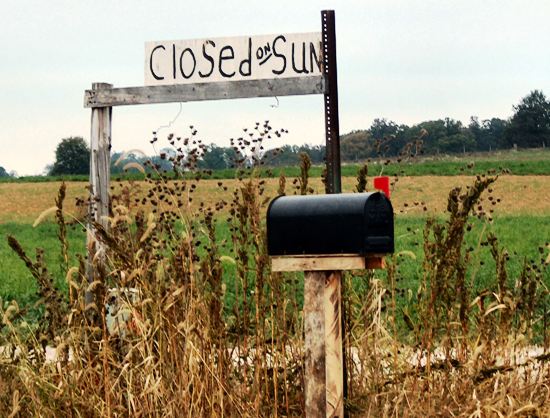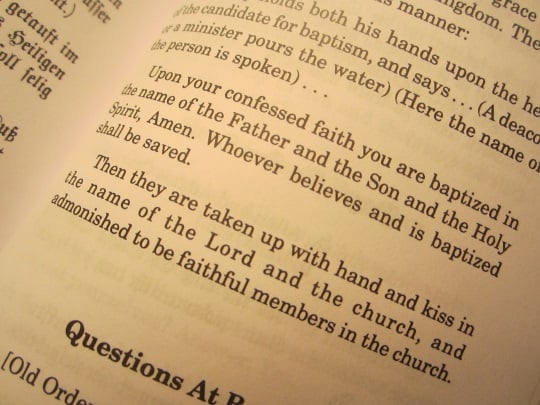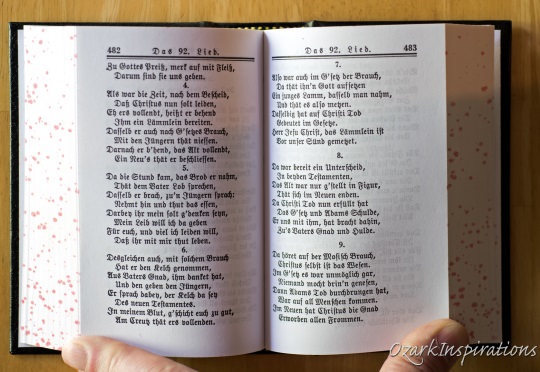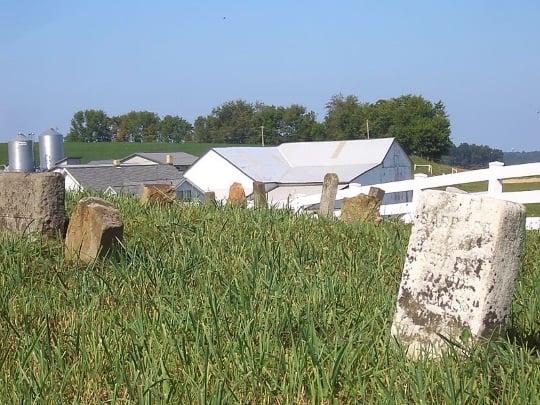Council Meeting in the Amish Church
Today I thought I’d touch briefly on Council Meeting, a special twice-yearly occasion happening now in Amish churches in Lancaster County and elsewhere.
Council Meeting: Preparing for Communion
Last Sunday while staying with Amish friends in Lancaster, I did not get an invitation to attend Amish church. Usually the family I was staying with asks if I’d like along. But last Sunday they had Council Meeting, which is members-only.
Council Meeting is meant to prepare the church for Communion which occurs two weeks later. The authors of The Amish Way describe it as “accent[ing] mutual submission and an affirmation of the Ordnung” (see The Amish Way, p. 70). At Council Meeting the Ordnung is reviewed and outstanding issues, such as “out-of-order” members, are addressed.

The first part of the service includes a sermon encompassing Old Testament stories of creation, the flood, and prophecies of a savior, to the life, death and resurrection of Christ. The “cornerstone scripture” is Matthew 18, with its themes of humility, forgiveness, and addressing sin in the church.
Members are encouraged to forgive and resolve disagreements. This is important because Council Meeting is a time of preparation to assure the harmony and purity required for Communion service (The Amish Way, p. 70).
The Ordnung & Church Issues
This second part is members-only, and is called Abstellung, meaning to place off-limits, or put away (The Amish Way, p. 70). This is the part when the Ordnung is reviewed and affirmed–including day-to-day aspects of Amish life such as clothing, technology, restrictions on work, as well as general admonitions against sin. Any non-members present (which would include unbaptized youth) will be dismissed to wait outside.
Issues in the church may be addressed at Council Meeting. For instance, in another church I know of, the behavior of one errant member will be addressed this year, after issues have built up over an extended period of time. “Issues” may include use of forbidden technology or attending services in another church (or a combination of things).
If problems remain in a church, it may prevent Communion from being held, or other church functions from being carried out, such as the ordaining of new ministers. Since problems in a church can impede the normal functioning of a church, they are taken seriously. And more importantly there are implications for the spiritual health of a congregation.
Issues in the church, and the impending excommunication of a member can cause great anguish, the more so if the person in question is a family member–brother, sister, child, or spouse. On the other hand, as an Amish person recently explained to me in so many words–it may be better for all involved to have it done with.
Communion Service
Two weeks after Council service, if a church is in harmony, Amish churches move forward with Communion.
Communion in the Amish church is held twice yearly, in the autumn and spring. It is the longest church service and the “high point of the Amish year” (The Amish Way, p. 73). It includes a long preaching schedule reviewing biblical history and the life, death, and teachings of Jesus Christ, affirmations of unity, and the partaking of bread and wine, as well as footwashing.
If you’d like to know more about these important religious events in the Amish calendar, I’d recommend The Amish Way for a more thorough account of both Council Meeting and Communion.







Council Meeting in Amish Church
Welcome back, Erik — I’m sure you are forgiven in keeping busy with your other projects, but understand sometimes things must take a back-seat to be able to finish up other projects!
The info on Council meetings was very informative, and thank you for that. I can see how the Amish remain committed to their beliefs and practices – all of it is taken very seriously, no doubt! They trully are a culture to learn from, in this day and time!
SharonR
Council Meeting in Amish Church
Thanks for checking in with us Erik. I was wondering if something happened or that I may have deleted myself from your site.
The subject/info about the Amish Council Meetings is very interesting. I’m always amazed at how you think of so many topics to discuss, and the depth that some of those discussions can take us. You are a walking Amish encyclopedia of sorts. Thank you for all you do and for the things you teach us. I hope you have enjoyed your vacation.
Galen
Want to post a statement
While traveling the NY Amish trail, i stopped by an Amish farm I have been to befor. The lovely Amish women referred to the Amish movies on TV today. She heard of them through other English who stop by to buy her wears. She said there is No such thing as Amish Maffua. That is against their beliefs. Also all those out of Amish shows are also false. As once they were filmed, they made the house to leave the Amish community and beliefs.do we (the English) realy have to trash such God loving people for entertainment? What are we going to do next? In the name of entertainment
I just had the same conversation with a couple in my church this morning. I’ve been going out to Amish country for a little over 12 years and also started studying the teachings of Luther, and most of all I know a great Amish couple, and I was talking with her husband about the t.v. show, the Amish mafia, and I asked him his view on that and the way he answered it was correct “What do u think? knowing what I do know about them is their non-violent God fearing people, the show is made for entertainment and chances are that a good percentage of people don’t do research on things they watch, they just assume it’s true because they think the producers researched it, were in America people you HAVE to research somethings yourself! If ratings can be made a show will be made.
Galen, very kind words. I don’t feel very encyclopedic but thanks regardless. I am glad for the help I get.
Council Sunday
As an aside, many Amish owned businesses/roadside stands in Lancaster County were closed for a “religious holiday” (according to signs) the Friday (10/11) before Council Sunday (10/13); we were told that the (Fri)day is one of fasting and preparation for the Council, and ultimately for Communion Sunday.
Erik?
Erik? Name sounds familiar. Erik? Who is he again?
Ohhhh, E-R-I-K! Yep, now I remember him. Welcome back our prodigal host!
Now, Old Kat — you leave Erik alone! It wasn’t his fault that he couldn’t get a WiFi connection on his kerosene powered laptop, due to a fouled wick.
Well glad to be back, and City Slicker has it mostly right 🙂
Mark's first Amish Ordnungs Gmay
Mark told me a story about his first time participating as a member in Ordnungs Gmay or in English, Council Meeting. Mark had never been to one as he was never before a member. Little did he know that as a part of the service the ministers come around to each member and bend over to listen and the member is supposed to whisper this sort of memorized statement that is called the “Orbeiter” in the minister’s ear. Mark didn’t know the spelling. That’s how it sounds, he says. Anyway, at that time he was working part time at the bulk food store. One of the other employees was a seventeen year old boy (who has sadly, since passed away). Anyway, Mark and Clinton were good friends and Clinton just happened to ask Mark if he’d memorized his “Orbeiter” statement. Mark says he was just panic stricken. He didn’t know anything about this. He didn’t know what he was supposed to say or anything. So, Clinton sat down and tried to write out, phonetically, what Mark was supposed to say. Mark still has that paper as a memory of Clinton who passed away shortly before he reached the age of eighteen. If you’d like to know what the “Orbeit” statement is I can ask Mark to spell it out for me and give the English translation. Anyway, Mark still uses that same Orbeit, unchanged, in memory of Clinton.
Nice story
You always tell the nicest stories. I am glad that Mark and you are willing to share some of these inside details.
Very interesting info – will you let us know if your friend’s church was able to solve any and all issues? And what a beautiful photo! (sunrise or sunset?)
That is sunrise last week. I don’t know how many details I’ll hear/be able to share. Didn’t sound too optimistic though.
I agree with Sharon R. other churches could take a cue from the Amish.
Erik, I was just wondering yesterday if you had given up on the site. So happy to see you are still there.
Thanks Debbie. No, this site isn’t going anywhere 🙂
Glad you're back!
It’s always good to get back to (virtual?) “normal”, isn’t it, Erik? I’m glad you had a good Lancaster visit, and vacation, besides. Looking forward to the fruits of your labor in the coming months!
Just what type of “statement” is the “Orbeiter”? I’m afraid I don’t understand its’ purpose. What does it refer to? The individual’s state of “grace” (or lack thereof)? I really want to understand this!
Is there any kind of limit as to how long a church district can “go” without communion, meaning there’s on-going trouble within the congregation? Have districts ever disbanded because of the disobedience of (some of) the membership? Communion being such a rare and solemn occurrence, how are members judged to be “worthy” (or not)? Very interesting!
Also, I thought that different Amish districts could visit other Amish districts’ church services on their own district’s “off” Sundays—is that not the case? Or does “visiting other churches “r efer to other denominations, like Mennonites, Baptists, Catholics, Lutherans, etc? (The more I think I know, the more I think otherwise!)
Alice Mary
Orbeiter
Okay. I’m going to try and attempt this with my almost ninety-one year old hands. Mark spelled it all out for me and gave me the translation. This is Mark’s Orbeit. They can vary a little I guess but all basically say the same thing.
“Ich bin einig mit der vor und abstellung und wan mir der mal di levie khalta wat es ist mein beghera fa so do. Ich will helva havva mit mein schwacheit, in di levie. Wan Ich hab enny elbbah beleidet I will augret wadda in die levie und I wit ah sell du. Und Ich wit der Ha sein segna winscha.”
Very loose Translation.
“I am totally agreed with the Ordnung as agreed upon by the church and ministry. It is my desire to hold communion with all the members of the church. I desire to have help with my weaknesses, in a loving way. If I have offended or hurt anybody I want to be made aware of this and corrected, in a loving way and I want to do this for others, also. I wish the Lord’s His blessing on this council meeting.
Touching story above, and great detail you’ve added here Don. Thanks to both of you.
I saw Mark made the Budget again.
Marcus Yoder
Where is Mark at?
Where is Mark living?
Belle Center Ohio. If you are looking at the Budget it would be under Bellefontaine- Belle Center.
Correction
I knew I’d mess up. I read what I had written to Mark and he corrected me. He said that what they say is called the “Dorbeiter” not “Orbeiter” like what I wrote. He said that it’s prounounced sort of like “Door Beater”. Oh well. I tried.
Council Meeting
My Beachy Mennonite Church also holds the same sort of Council Meeting. After sermons, members are given a chance to speak up regarding any sins or shortcomings they may have. Then is the time for each Member’s Statement which would include the following: I have Victory over Sin, Peace with God and my fellow man (as far as I know), a desire to Commune, I am willing to follow the Church Standards, I am open to correction from anyone who sees and shortcomings in my life and accept Jesus as my Savior. We also hold Communion twice a year, Spring and Autumn. Our unofficial website is http://www.BeachyAM.org
Council Meeting in the Amish Church
That was such a beautiful picture. I felt like I was there. Glad you are back. When you go on those trips you always have a “wealth of information to share with those of us who couldn’t go on the trip.
Their Council Meetings don’t sound too much different from our all church meetings that occurred in the church my family and I attended.
Thanks for sharing.
Glad you’re back with Amish America posts, Erik. I was beginning to think I was going to have to send a notice to the “Information Please” column in The Budget asking if any Amish people anywhere knew what had happened to Erik Wesner.
In The Budget this time of year in the letters from many Amish communities, I read of them having their council meeting and then on another Sunday having their communion service. And a big thanks to Don and Mark, as always, for sharing new information about Amish life. The orbeiter statement is very interesting.
I think I was in non-Budget-reading households on this trip, but if I were in Ohio, you might have gotten a response–one of the families I spend time with there has a Budget scribe among the ranks 🙂
Welcome Back!! Thank you for all your hard work!!
I was a little worried, but I figured you were on vacation and not near electricity to update.
Thanks Katrina and everyone else–yes internet is sometimes a challenge to posting, one which I can usually overcome, but there was just a bit too much going on this past visit. I may need to just find a mobile internet solution one of these days.
Orbeiter
Thanks for sharing that story, Don. Very interesting! Welcome back, Erik!
Interesting
This is an interesting article and replies. Welcome back, Erik, I hope the trip into Amish country was enjoyable.
I wonder, is the Church Council/Communion season the times when the Amish select ministers and or make promotions into the different “ranks” in the ministry?
I like Mark and Don’s presentation of what the “Orbeiter” is, I had no idea of what what was, before, thank you for sharing (you learn something new every day).
Communion service is when minister selection commonly happens (there is a bit on this in Amish Way too). The main sort of “promotion” is really from minister to bishop, which follows a similar selection process.
I've missed you-- and everyone else!
Erik– glad you had a respite from the usual daily tasks, even if some were a bit missed– however, truly the basis for R & R! It’s also nice having you — and, therefore, the rest of the community –back in my daily email reading!
Thank you Don and Mark for sharing — and Erik for publishing the information. Over the years in 3 or 4 of the churches in which I was a member, there was great division for one reason or another, resulting in quite a bit of confusion, hurt, and faith-damage. I can’t help but think that a twice yearly “accounting” by members, confronting “issues” with one another in a grace-filled service would perhaps have given everyone perspective, imparted wisdom, cleared the air of misunderstanding and selfish expectation. Then, to take and make personal accountability for one’s beliefs and affirmation of membership within the community would have given all a renewed sense of unity — the essence of communion with one another in Jesus Christ.
Thank you for bringing the topic up. It’s given me a great deal of inspiration and rumination.
Very much appreciated Sandra Kathleen. Glad it has given something to ponder.
Numbers?
Could you tell me how many men sit on the counsel? What are their “rankings”? Bishop, Deacon, Ministers etc… Any information would be helpful! 🙂
Hi Jeff, give this article a try:
https://amishamerica.com/who-leads-the-amish-church/
Amish churches typically have one bishop (either exclusive to that district or “shared” among two), 2 or 3 ministers, and a deacon.
Thanks Erik! I thought it was very much like that but wasn’t totally sure. I had heard mixed/ overlapping numbers and it threw me for a loop! 🙂
God obey is most important
the most important step is to keep in daily touch & daily pray to Mighty God as Unitarian . as regarding boys & girls keep following them , sitting with them give daily advices not to be attracted by bad new technology tell them stories of God Messengers , go to hills after sunset & imagine you are with God while God obey is most important to be real human . evil is trying always to spoil mankind in alcohol & illegal sex , drugs , bad money . again sit with your children , youth and pray daily to God by your heart God is watching you !!!.